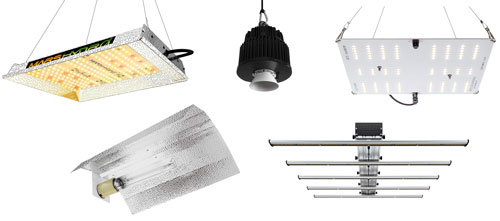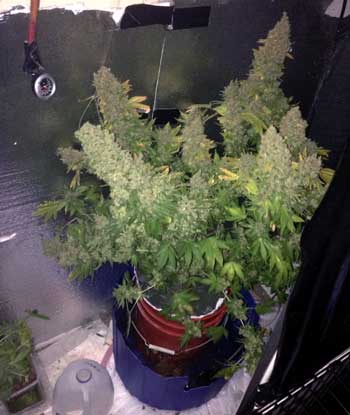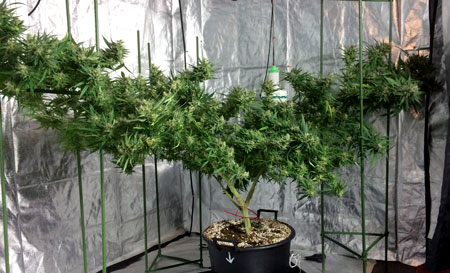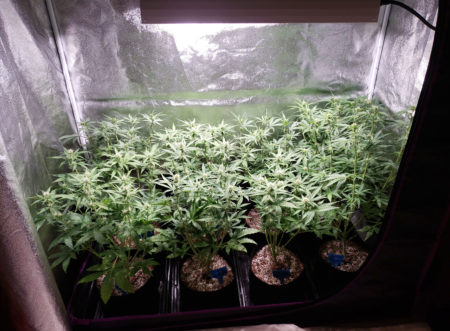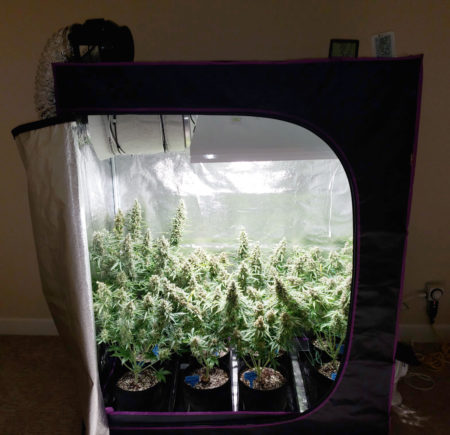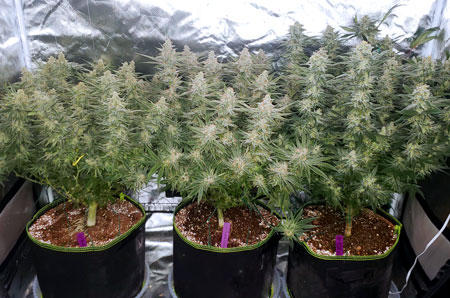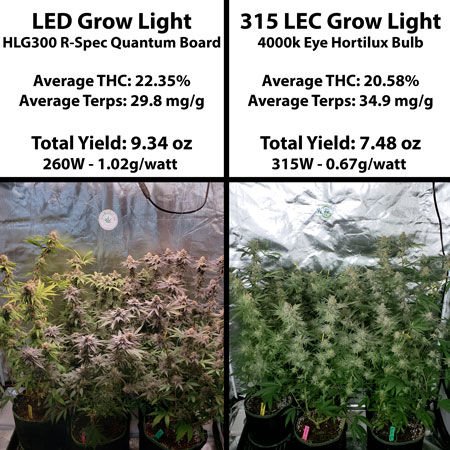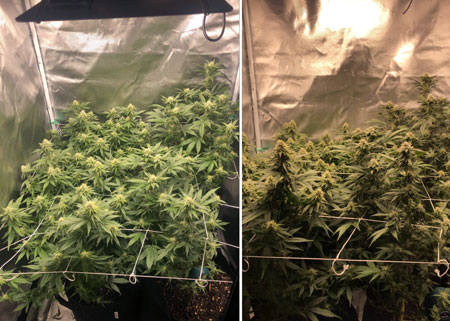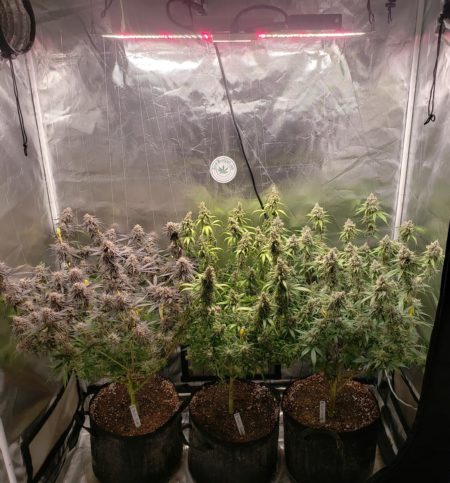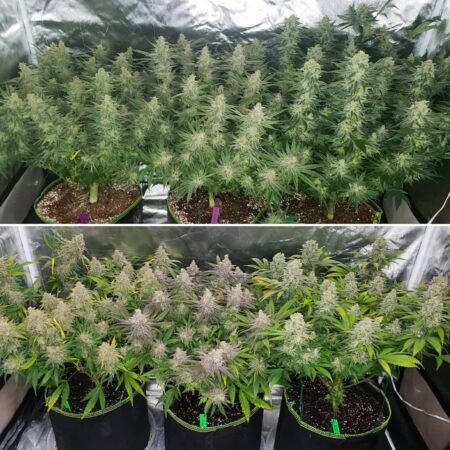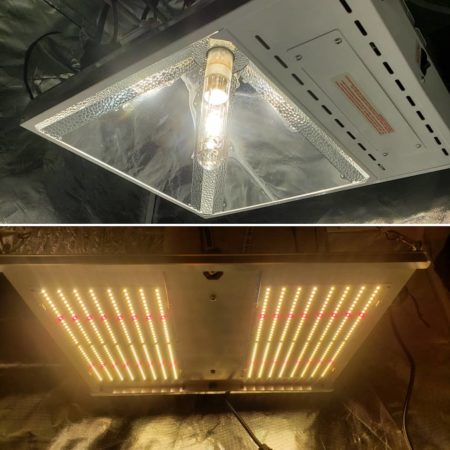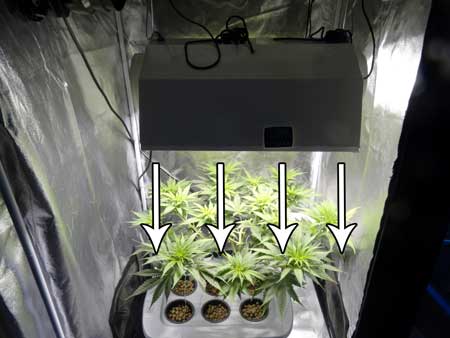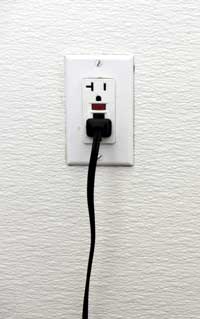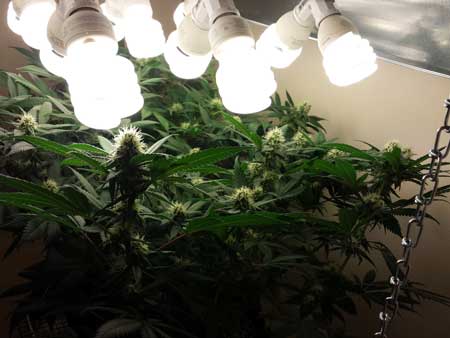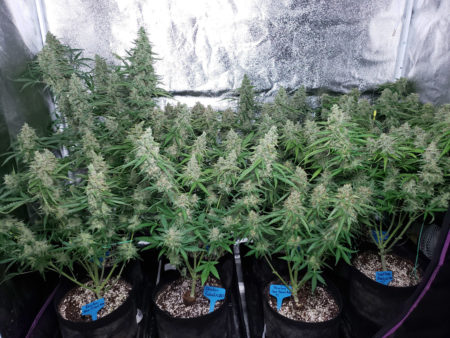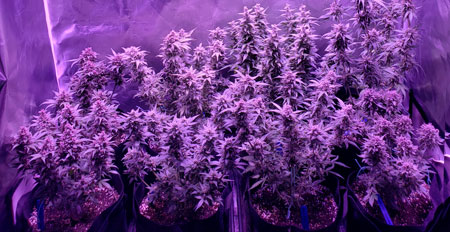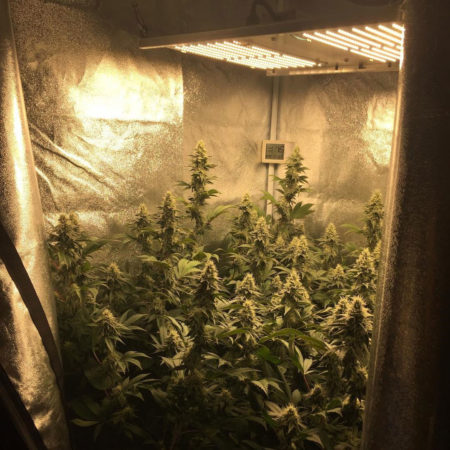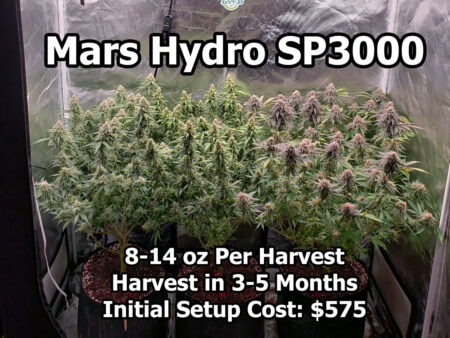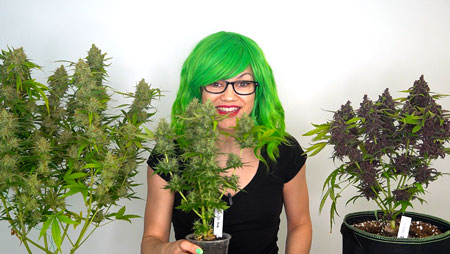by Nebula Haze
Are you struggling to choose the best grow light for your cannabis plants? You’re not alone! It’s common to feel overwhelmed after cruising Amazon or an online grow shop looking at different grow lights. The number of options can be insane. Are LED grow lights the way to go? If so, should you buy standard LEDs, a quantum board, an LED puck, or something else? For example, a Mars Hydro TSL-2000 (what I’m using right now) or Spider Farmer SF-2000 (check out my grow journal) both seem like great LED grow lights for growing weed, but the names are so similar. What’s the difference? Which is better? And what size grow light do you need to get the yields you want? No more wondering! Today you’ll get the answers…
3 Most Common Cannabis Grow Light Questions
- What’s the best size grow light for X number of plants?
- Which cannabis grow light for a 2×4, 3×3, or 4×4 grow area? (and other sizes)
- What yields can I expect for each size grow light?
So many different sizes (and types)! Which is the best cannabis grow light for you?
1.) What’s the best size grow light for X number of plants?
Before I answer this question, let’s talk about plant numbers. It can be hard to decide the right number of plants to grow. Many home-grow laws limit growers to somewhere between 1-6 plants. While it’s easier to grow only a few plants at a time, more plants result in more strains and often bigger yields at harvest.
This plant produced excellent yields but the harvest would have been bigger without empty space under the grow light. Adding more plants would have filled that space quickly. Growing just one plant at a time also creates a single point of failure. If something happens to the plant (like it herms or gets sick), then you are completely out of plants.
A single cannabis plant produces better yields if it’s trained to grow flat and wide, but that can add several weeks before harvest.
For example, one plant could be trained over several weeks in the vegetative stage to grow into the following shape (and achieve about the same results at harvest), but 8 plants filled this canopy in just 30 days from germination. Multiple plants can produce a quick harvest with big yields due to how fast they fill a grow space in the vegetative stage.
The result of those 8 plants was a big harvest only 3 months from germination. Who doesn’t love a quick bountiful harvest? However, more plants take more work. It was kind of a pain to take care of 8 plants at once in such a small space.
I believe 2-4 plants per grow is a great compromise between effort and results for a small-scale home grower. But every grower is different!
Now that you’ve chosen the number of plants, let’s talk grow light size. You need to decide how much bud you want to yield per plant. That’s key to choosing the perfect size light for your goals.
I want to yield an average of…
- 1-2 oz per plant – 50W per plant
- 3-4 oz per plant – 100W per plant
- 5+ oz per plant – 150+W per plant
Note: Some grow lights are better suited for growing cannabis than others. That means you could get two 300W grow lights that produce wildly different yields. However, these numbers offer a rough estimate. And remember, regardless of the type of light, you can achieve better yields with high-yielding genetics and grower experience.
These two tents had clones grown in identical conditions except for the grow light. The left tent used an HLG300 R-Spec LED and the other used a 315W LEC grow light (with 4000k bulb). Even though both lights used a comparable amount of electricity (around 300w), the LEC tent produced more trichomes and higher levels of terpenes while the HLG grow light produced higher yields and THC production. Even though the electricity use was similar, and the clones had otherwise identical environment (temperature, nutrients, grow medium, watering schedule, etc.), the results between the clones was surprisingly different due to the different types of light.
True power draw vs equivalent wattage – Whenever talking about the wattage, pay attention to the “true power draw” (how much electricity is being drawn out of the wall) to estimate the strength of the grow light. Ignore “equivalent” wattages because these are marketing terms without any objective meaning.
Why the confusing labeling? In the 2000s, the most popular grow light was the 600W HPS. When LEDs first came out, they were all labeled as “600w HPS equivalent” even though they used a fraction of that electricity and got a fraction of the yields. It makes sense as a marketing gimmick: doesn’t a “600w equivalent” light sound more powerful than a 100w LED? The practice of non-sensical LED labeling has persisted for over a decade, though it seems to finally be falling out of favor. You don’t need high wattage to get big yields, and growers are starting to realize the power of utilizing objective numbers instead of “equivalents” that are made up by marketing teams.
Examples of recommended grow lights with real talk about what to expect:
- Mars Hydro TSL 2000W LED grow light is “2000W equivalent” but only uses 300W. When estimating yields and plant numbers, go by the true power draw (300W) as opposed to the equivalent. By looking at the chart above, that means the 300W light could expect up to 10 oz with 2-6 plants. 8-10 oz is about average for an average-to-good grow.
- Spider Farmer SF-2000 LED grow light also has “2000” in the name, but this one uses 200W out of the wall. That means you would normally expect up to 7 oz with 1-4 plants. However, the Spider Farmer lights seem to perform better than average per watt in my experience and with growers who’ve written in. My cannabis plants produced 10 oz on my first try with this light, and others have reported 8 oz.
I hope this helps demonstrate why you need to look for both the grower results and true power draw to compare lights as opposed to just looking at the “equivalent” number on an LED grow light. Luckily, many reputable LED brands are switching from equivalent to real wattages in their product names. For example, HLG lights like the HLG 600 R-Spec are listed accurately. The name says 600 and actually uses 600W, which means a grower could expect about 20 oz with 4-12 plants.
Spider Farmer SF-2000 LED grow light in action. This light yields up to 8 oz on a good grow with 1-4 plants. Grower comment: “Picture talks!”
My first grow with the Spider Farmer SF-2000 produced over 10 oz with 3 plants
In my grow journal, LEDs performed well in both super soil and coco coir.
2.) What size grow light for a 2×4, 3×3, or 4×4 grow tent? (Metric 0.6mx0.6m or 1mx1m, etc.)
Some growers just want to maximize the electricity used, others care more about making the biggest yields, and some growers care most about making things easier. Here are some important tips to remember when it comes to choosing the right size grow light for your grow space:
- Light footprint – Just about every grow light has a recommended light footprint, which is usually listed in the product details by the manufacturer. For example, it may say the recommended footprint is 2’x4′ for the flowering stage. That means that this light is designed to grow plants in that size space. Even more than the recommendations below, it’s highly recommended you go by the manufacturer’s recommendation first.
- How to get the best yields for electricity – Some lights are more electrically efficient than others. Generally, the smaller LED grow lights (under 300w or so) run the most efficiently and get the best yields for the amount of electricity used. Fluorescent grow lights like CFLs and T5s tend to get the worst yields for the wattage. It also helps maximize efficiency by getting a smallish light for your grow space. That’s because there will be some extra light around the edges that add small but significant amounts to your yields without using any more electricity. As a bonus, it’s easier to manage heat in a space that’s somewhat bigger than necessary.
- How to get the best yields for space – If you care more about maximizing yields for a particular space, it’s recommended to get the most powerful grow light your space can support. LEDs and HPS grow lights get the biggest yields for the amount of space used. Once you get to the bigger sizes (above 500W or so), typically an HPS will get better yields for the amount of space (if not necessarily the most electrically efficient). A 600W HPS grow light in a 4’x4′ grow tent is an excellent choice that costs about $800 to get set up and can produce over 20 oz per harvest. Of all the HPS lights, the 600w size is the most efficient. If you are willing to deal with a lot of heat, you can even fit a 1000W in a 4’x4′ grow space and produce 35 oz or more. When using bigger lights in a relatively small space, it becomes more important than ever to create a great exhaust system to vent heat.
- True wattage – When shopping for grow lights, look for the true power draw or amount of electricity used to run the grow light. This is often found buried in the product details. The actual wattage used helps you compare different grow lights directly. Often this number is different from the number in the LED grow light’s name (examples below)
Each grow light has a recommended light footprint. Look at the product details to make sure a grow light is designed for your size grow space to ensure the best results.
Each grow light is optimized to provide full coverage to a specific amount of space
Some common size grow tents are:
- 2’x2′ (also 24″x24″ or 60cm x 60cm) – Up to 150w
- 2’x4′ (also 48″x24″ or 120cm x 60cm) – Up to 400w
- 3’x3′ (also 36″x36″ or 90cmx90cm or sometimes 1mx1m) – Up to 400w
- 4’x4′ (48″x48″ or 120cm x 120cm or 1.2mx1.2m) – Up to 600w or 1000W if you have a great cooling system
Note: Watt recommendations are always based on true power draw. This is the amount of electricity being pulled out of the wall.
3.) What yields can I expect for each size grow light?
You’ll see that a lot of these questions are closely connected to each other. Yields and number of plants and grow lights, oh my! This section looks at not just wattages but also type of grow light. Here’s information about the average yields to expect by grow light type
Fluorescent lights – CFLs & T5s
- 0.25-0.5 g/watt (100w = 25-50g)
- for the best yields, keep plants short and flat, with grow lights close
HIDs – CMH/LEC & MH/HPS grow lights
- 0.5g-1g/watt (400w = 7-14 oz)
- these lights get hot; perfect for winter
- excellent yields and bud density when heat is under control
LEDs – many models and kinds (check out this list of my recommended LED grow lights for growing cannabis)
- 0.5-1g/watt (300w = 5-10 oz) – huge variability; some LEDs do worse while other LED models can easily beat these numbers
- LEDs tend to run cool and plants can better handle heat; perfect for summer growing
- I’ve noticed the best LEDs for cannabis usually produce white light with pink or yellow undertones (here’s my current LED setup with a 300W quantum board)
- Black/purple LEDs (“blurples”) tend to get worse cannabis yields/watt than the fuller spectrum LEDs
Typically the “blurple” LEDs don’t produce as well as the LEDs with a wider color spectrum (though not always)
The best-yielding LEDs for cannabis in the flowering stage usually have a pinkish or yellow-white light. However, every model of LED is different
Here’s the LED setup I’m using right now (highly recommended)
Conclusion: How to Choose the Best Cannabis Grow Light
The best cannabis grow light for you depends on your individual needs, space, and goals. Whether you want to tend a couple of plants in a closet, or dedicate a whole room to your cannabis garden, choosing the right grow lighting is the key to getting the best yields.
Consider your grow space, the number of plants, and the yields you’re aiming for, and refer to the article to determine what grow light is best for you. Don’t get confused by marketing terms like “equivalent wattage.” Instead, focus on the true power draw and the actual results reported by other cannabis growers. Investing in a quality light might seem expensive at first, but it pays off in the form of dense, potent buds, higher yields, and an overall more fun and productive hobby experience.
Of course, don’t forget to pay attention to your plants, react quickly if you notice unusual markings or other symptoms, and stay curious when you encounter challenges. Most importantly, never stop learning!
If you want to reach “master grower” status as soon as possible, sign up for our weekly newsletter and get free grow tips and tutorials delivered to you every Sunday.
Happy growing!
Nebula Haze
Nebula Haze – Co-Founder of GrowWeedEasy.com

